

Bitbank2/AnimatedGIF: A lightweight Arduino GIF decoder for playing animated files from memory or files on SD cards. Playing gif's with Esp32 & TFT Lcd display - ESP32 Forum. ESP32 Tutorial: Sampling Audio via the ADC. The ESP32 is a next-generation, WiFi- and Bluetooth-enabled microcontroller.
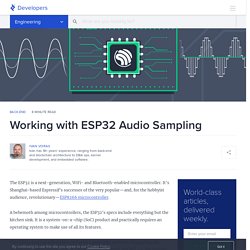
It’s Shanghai-based Espressif’s successor of the very popular—and, for the hobbyist audience, revolutionary—ESP8266 microcontroller. A behemoth among microcontrollers, the ESP32’s specs include everything but the kitchen sink. It is a system-on-a-chip (SoC) product and practically requires an operating system to make use of all its features. This ESP32 tutorial will explain and solve a particular problem of sampling the analog-to-digital converter (ADC) from a timer interrupt. We will use the Arduino IDE. ESP32 Audio: Timers and Interrupts The ESP32 contains four hardware timers, divided into two groups. Some of the important distinct timer modes are: The timer is disabled. Timers’ counters can be read by arbitrary code, but in most cases, we are interested in doing something periodically, and this means we will configure the timer hardware to generate an interrupt, and we will write code to handle it.
HTTP Client Code for Embedded Systems. Embedded devices that run HTTP client software have a convenient means of exchanging messages with “real-world” Web servers lying outside their local area network.
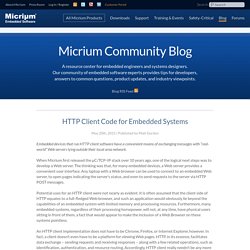
When Micrium first released the µC/TCP-IP stack over 10 years ago, one of the logical next steps was to develop a Web server. The thinking was that, for many embedded devices, a Web server provides a convenient user interface. World Time API: Simple JSON/plain-text API to obtain the current time in, and related data about, a timzone. API Documentation - MuslimSalat.com. Prayer times made available through api, so everyone can benefit the easy access for prayer times with less effort to develop custom applications for verity of software's / application's.
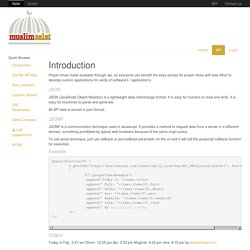
JSON (JavaScript Object Notation) is a lightweight data-interchange format. It is easy for humans to read and write. It is easy for machines to parse and generate. All API data is served in json format. JSONP is a communication technique used in Javascript. To use jsonp technique, just use callback or jsoncallback parameter on the url and it will call the javascript callback function for execution. Example Output: Today in Fajr: 3:47 am Dhuhr: 12:05 pm Asr: 3:33 pm Maghrib: 6:33 pm Isha: 8:15 pm by MuslimSalat.com Get My API Key To get started with api request, you will need api key. Auto Location. Responses. Hello World with ESP32 Explained - Tutorials. The Espressif Internet Development Framework (ESP-IDF) uses FreeRTOS to make better use of the two high speed processors and manage the numerous built-in peripherals.
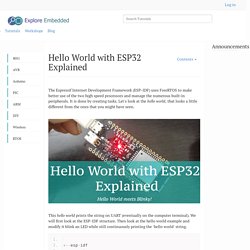
It is done by creating tasks. Let's look at the hello world, that looks a little different from the ones that you might have seen. This hello world prints the string on UART (eventually on the computer terminal). We will first look at the ESP-IDF structure. Then look at the hello world example and modify it blink an LED while still continuously printing the 'hello world' string. Secure IOT with AWS and Hornbill ESP32 - Tutorials. Security of connected devices is of paramount concern.

There are several possible ways to make the devices secure. One of the most essential and widely used options is to use end to end encryption. The widely used Transport Layer Security (TLS) version 1.2 is the latest standard used on web for secure connections including banking. ESP32. ESP32 (38) – Factory reset In the previous two posts of this tutorial, I explained how to perform an over-the-air update of the firmware running on the esp32 chip.

Sometimes you may need to revert to the factory firmware, ESP32 (20) – Webserver. One of the most popular projects among the ones included in my tutorial about the enc28j60 chip is fore sure WebRelay.

This project allows to control an output pin of Arduino using a simple web page, designed to be accessed also using your smartphone. Today I’m going to show you how to implement a similar project with the esp32 chip; it’s also the opportunity to teach how to write a TCP server, especially a web server. In-depth: Create A Simple ESP32 Web Server In Arduino IDE. The newly launched successor of ESP8266 – the ESP32 has been a growing star among IoT or WiFi-related projects.
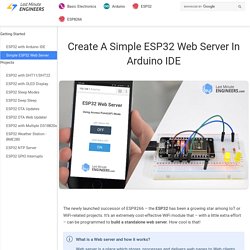
It’s an extremely cost-effective WiFi module that – with a little extra effort – can be programmed to build a standalone web server. How cool is that! IoTBits - Design your Internet of Things, bit by bit ! Wi-Fi Driver — ESP-IDF Programming Guide v4.0-dev-402-ga20d02b7f documentation. ESP32 Wi-Fi Feature List¶ Support Station-only mode, AP-only mode, Station/AP-coexistence modeSupport IEEE-802.11B, IEEE-802.11G, IEEE802.11N and APIs to configure the protocol modeSupport WPA/WPA2/WPA2-Enterprise and WPSSupport AMPDU, HT40, QoS and other key featuresSupport Modem-sleepSupport an Espressif-specific protocol which, in turn, supports up to 1 km of data trafficUp to 20 MBit/sec TCP throughput and 30 MBit/sec UDP throughput over the airSupport SnifferSupport set fast_crypto algorithm and normal algorithm switch which used in wifi connectSupport both fast scan and all channel scan featureSupport multiple antennasSupport channel state information How To Write a Wi-Fi Application¶ Preparation¶ Generally, the most effective way to begin your own Wi-Fi application is to select an example which is similar to your own application, and port the useful part into your project.
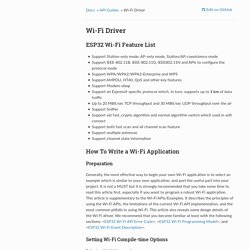
Heap Memory Allocation — ESP-IDF Programming Guide v3.2 documentation. Stack and Heap¶ ESP-IDF applications use the common computer architecture patterns of stack (dynamic memory allocated by program control flow) and heap (dynamic memory allocated by function calls), as well as statically allocated memory (allocated at compile time).
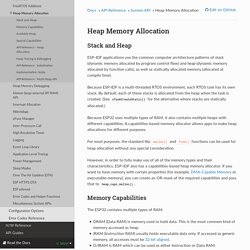
ESP32 - Cheapest IoT WiFi and Bluetooth ready module. Introduction While ESP8266 is still one of the most used WiFi development board in handmade IoT projects, the new ESP32 is getting allot attention. Although its not so new, the ESP32 popularity has began to grow in the last year mostly because of its Bluetooth capabilities, but not only. The ESP32 comes now with almost 32 I/O pins and a powerful 32bits dual core CPU ready to process more complex jobs. Despite those new features, the ESP32 development board can still be bought with under 15$, but does it worth it?
Learn ESP32 with Arduino IDE Course. This is a practical course where you’ll learn how to take the most out of the ESP32 using the Arduino IDE. This is our complete guide to program the ESP32 with Arduino IDE, including projects, tips, and tricks! What’s inside the course? The course contains 8 Modules to take the most out of the ESP32. We’ll start by introducing the ESP32 main features and explore its GPIOs.
We’ll also cover a variety of subjects related with IoT like Web Servers, Bluetooth Low Energy (BLE), and LoRa. Here’s what you’ll have access with this course: Course dashboard with video, code, schematics, and transcriptsAll 8 Modules (downloadable eBook in PDF format with 510 pages)Module #8 includes 4 advanced ESP32 ProjectsWatch and Download the Video CourseSource Code + Full SchematicsUnlimited UpdatesExclusive access to a private Forum to ask questionsExclusive access to our Facebook group community Table of Contents.
ESP32 Web Server - Arduino IDE. In this project you’ll create a standalone web server with an ESP32 that controls outputs (two LEDs) using the Arduino IDE programming environment. The web server is mobile responsive and can be accessed with any device that as a browser on the local network. We’ll show you how to create the web server and how the code works step-by-step. If you want to learn more about the ESP32, read Getting Started Guide with ESP32. Watch the Video Tutorial. Prepare FAT image and flash it to ESP32 - ESP32 Forum. Here is a tool to prepare FAT image on host and flash it to esp32. The tool is inspired by mkspiffs tool created by loboris. Full example of using spiffs with ESP32 - ESP32 Forum. The example source code can be found on GitHub: How to build Configure your esp32 build environment as for other esp-idf examples Clone the repository Code: Select all git clone Execute menuconfig and configure your Serial flash config and other settings.
Prepare SPIFFS image It is not required to prepare the image, as the spiffs will be automatically formated on first use, but it might be convenient. SFPIFFS image can be prepared on host and flashed to ESP32.New: Tested and works under Linux, Windows and Mac OS. Copy the files to be included on spiffs into components/spiffs_image/image/ directory. ESP-IDF SPIFFS can't find files on ESP32? - ESP32 Forum. I got this working last night. There is allot the docs assume you already know I am still honing in values but this should get you started as well. #1) create a "partitions.csv" file in your project folder. This is what I have in there. Code: Select all Name, Type, SubType, Offset, Size, Flags Note: if you change the phy_init or app partition offset, make sure to change the offset in Kconfig.projbuild nvs, data, nvs, 0x9000, 0x6000, phy_init, data, phy, 0xf000, 0x1000, factory, app, factory, 0x10000, 1M, storage, data, spiffs, 0x210000 , 1M,